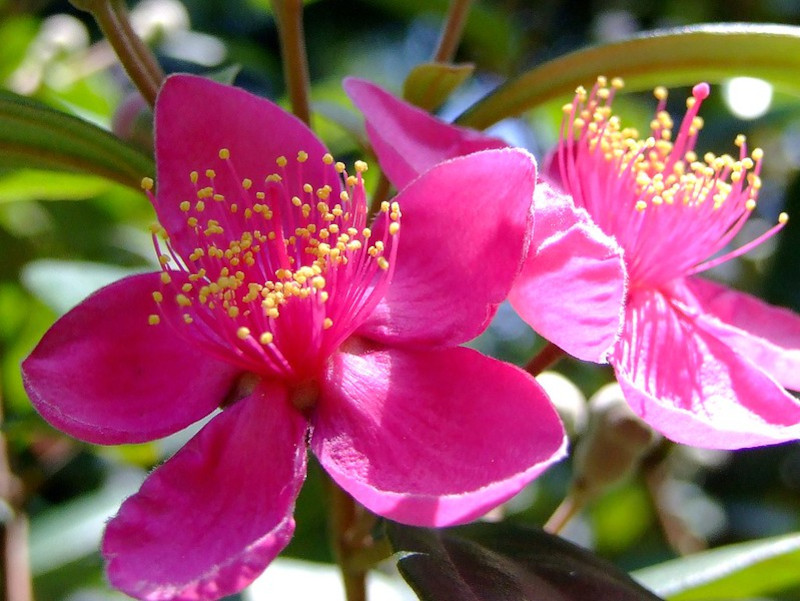
Rose Myrtle Facts
- This stunning creation of Nature and evolution is most frequently referred to by the simple yet appropriate common name of Rose Myrtle. It also has other general titles, too. These include such terms as Feijoa, Downy Nyrtle, and Ceylon hill gooseberry.
- Inside of the scientific community, however, it’s perhaps better known by its technical label. Sadly, that’s an extremely difficult epithet for the layperson to pronounce. That’s because this natural wonder holds the official tag of Rhodomyrtus tomentosa.
- This beautiful Angiosperm received that formal moniker due to the efforts of William Aiton. The noted Scottish botanist accomplished the first recognition of it as a separate and distinct species. He managed that scientifically noteworthy deed in 1842.
- Fortunately, the gorgeous Rose Myrtle appears to be maintaining a base population that’s both stable and sufficient. That pleasant state further seems to hold true across the entirety of its range. The IUCN therefore presently lists it as Least Concern.
- The species nevertheless should be considered to be facing several potential threats to its existence, at least. Like most species, many of these stem from the actions of mankind. They include such related dangers as habitat loss and climate change.
Related Articles
Rose Myrtle Physical Description
The magnificent Rose Myrtle certainly merits every bit of the appreciation it receives from most of those lucky enough to view it. Yet, it doesn’t earn its accolades only due to its visual appeal. That’s true since it also boasts some relatively impressive physical dimensions.
Understandably, individual specimens frequently vary greatly in size. This largely occurs due to variations in local environmental factors. Maximum recorded heights, however, measure approximately 12 ft (3.7 m). Few examples of the species attain quite this size, though.
Depending upon the individual plant, each has either a single or multiple trunks. These features remain comparatively thin in relation to the branches, regardless of the height it reaches. As the woody shrub matures, these also develop somewhat scaly, light brown bark.
From each trunk, though, a large multitude of small branches project. In turn, each of these produces a number of leaves. Evergreen in nature, these develop in opposition to one another on short stems. This lovely foliage also manifests a somewhat leathery texture.
The leaves further attain an average length of 2 – 2.8 in (5 – 7 cm). In width, though, these only have a mean measurement of 0.8 – 1.4 in (2.0 – 3.5 cm). These also evolved an oval shape, with a sharp point. In color, they’re glossy green above, and grayish beneath.
It’s the flowers of the Rose Myrtle that typically garner the most attention, though. Uniquely, the blooms appear either singly or in small groups. They average 0.8 – 1.4 in (2 – 3.5 cm) wide, pink or purplish-pink inside, and usually tinged white on the outside.
Meanwhile, the fruit also has its own qualities to appreciate. It actually varies in shape, having either 3 or 4 cells. This also averages 0.4 – 0.6 in (1 – 1.5 cm) in length. It further displays a distinctive deep-purple hue. Each cell usually contains between 40 – 45 small seeds.
- Kingdom: Plantae
- Phylum: Tracheophyta
- Class: Magnoliopsida
- Order: Myrtales
- Family: Myrtaceae
- Genus: Rhodonyrtus
- Species: R. tomentosa
Rose Myrtle Distribution, Habitat, and Ecology
The mesmerizing Rose Myrtle evolved as endemic to a moderately large swathe of the earth’s surface. The location of that zone of habitation likely won’t surprise many who learn of it, though, That’s because this botanical wonder evolved as native to parts of Asia.
Within the greater confines of that continent, the plant appears natively in sections of both the southern and southeastern areas. That territory extends from India to the Phillipines, and Indonesia. It’s currently unknown if it ever appeared beyond this present range.
Thankfully, Nature provided the flora with a distinct evolutionary advantage that some related species lack. That’s in the fact that it displays a high degree of versatility regarding its choice of habitat. It thus makes its home in a wide variety of different ecosystems.
Some of these differing areas include regions of coastline, moist or wet forests, wetlands, and deciduous forests. It’s also even found along the fringes of bogs. It additionally lives at a broad range of altitudes. These range from sea level to about 7,000 ft (2,134 m) above that.
The Rose Myrtle achieves pollination primarily via the actions of locally prevalent bee species. Various other insects also contribute to this, though to a smaller degree. Unlike some similar flora, this marvel of evolution does not reproduce via any vegetative means.
Following the formation of seeds, however, it accomplishes reproduction through the actions of different animals. Birds and other creatures often consume the fruit. Later, these spread in the droppings of the animal. Seeds also germinate where they fall from the plant.
Species Sharing Its Range
Check out our other articles on 4 Gorgeous European Gorges, Golden Jackal, Deception Island, Texas Blind Salamander, East African Lowland Honey Bee, Tiger Shark, Alligator Snapping Turtle
